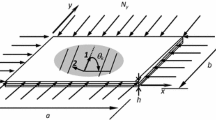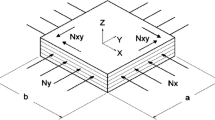Abstract
The object of the study was to optimize the shear buckling load of laminated composite plates. The laminates lacked coupling between bending and extension (B ij=0) but had otherwise arbitrary selection of the ply angle variation through the thickness. The plates were rectangular and either simply supported or clamped on all edges. For orthotropic plates, it was seen that there is only one parameter necessary for finding the optimal design for different materials and plate aspect ratios. This parameter can be interpreted as the layup angleθ in a (+/−θ) orthotropic laminate. When bendingtwisting coupling is present, the buckling strength depends on the direction of the applied load. A laminate with non-zero bending-twisting coupling stiffnesses can be described with four lamination parameters. The allowable region of these parameters was investigated, and an optimization of the buckling load within this region was performed. It was seen that even this is a one parameter problem. This parameter can be interpreted as the layup anlgeθ in an off-axis unidirectional laminate (θ).
Similar content being viewed by others
Abbreviations
- A ij :
-
in-plane stiffnesses of anisotropic plates, Tsai and Hahn (1980)
- B ij :
-
coupling stiffnesses of anisotropic plates
- D ij :
-
bending stiffnesses of anisotropic plates
- D *ij :
-
normalized bending stiffnesses
- a, b, h :
-
length, width and thickness of the plate
- x, y :
-
in-plane coordinates
- z :
-
through-the-thickness coordinate
- z * :
-
normalized through-the-thickness coordinate
- w (x, y) :
-
out-of-plane deformation
- N xy :
-
shear buckling load
- W *1 toW *4 :
-
lamination parameters
- U 1 toU 5 :
-
linear combinations of the on-axis moduli
- θ(z) :
-
layup angle
- f k :
-
functional ofθ(z)
References
Ashton, J.E.; Whitney, J.M. 1970:Theory of laminated plates. USA: Technomic
Cohen, G.A. 1982: Effect of transverse shear deformation on anisotropic plate bending.J. Comp. Mat. 16, 301–312
Grenestedt, J.L. 1990: Composite plate optimization only requires one parameter.Struct. Optim. (to appear)
Hirano, Y. 1979: Optimum design of laminated plates under shear.J. Comp. Mat. 13, 329–334
Housner, J.M.; Stein, M. 1975: Numerical analysis and parametric studies of the buckling of composite orthotropic compression and shear panels.NASA TN D-7996
Miki, M. 1985: Design of laminated fibrous composite plates with required flexural stiffness. In: Vinson, J.R.; Taya, M. (eds.)ASTM STP 864, pp. 387–400. Philadelphia: ASTM
Seydel, E. 1933: On the buckling of rectangular isotropic or orthogonal-isotropic plates by tangential stresses.Ing. Archiv
Thielemann, W. 1950: Contribution to the problem of the buckling of orthotropic plates.N.A.C.A. Technical Memorandum 1263
Tsai, S.W.; Hahn, H.T. 1980:Introduction to composite materials. USA: Technomic Westport CT
Author information
Authors and Affiliations
Rights and permissions
About this article
Cite this article
Grenestedt, J.L. Layup optimization against buckling of shear panels. Structural Optimization 3, 115–120 (1991). https://doi.org/10.1007/BF01743281
Received:
Revised:
Issue Date:
DOI: https://doi.org/10.1007/BF01743281




